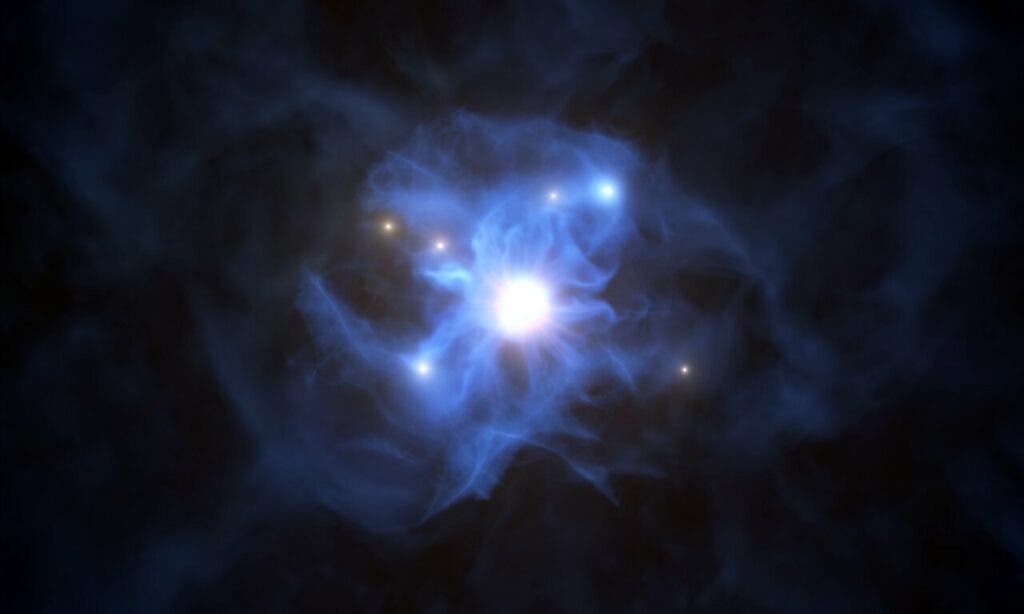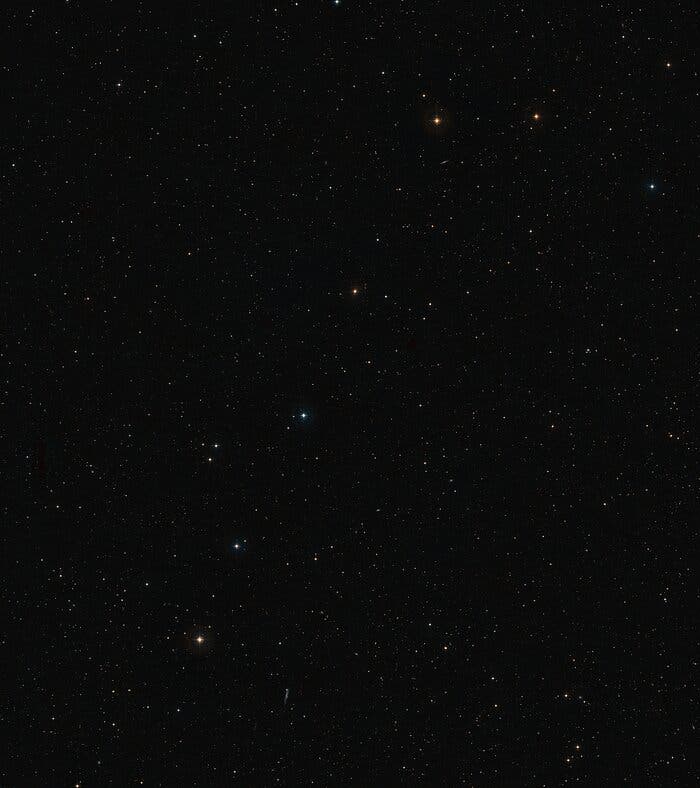Astronomers have discovered a tremendous cosmic web in the early Universe. Trapped within its threads are six galaxies feeding gas to a central supermassive black hole.
Astronomers have made a startling discovery in the early Universe: six galaxies suspended in the cosmic web of a supermassive black hole. The finding represents the first time such a grouping has been found when the Universe was young — just under a billion years after the ‘Big Bang.’
The cosmic web with its suspended galaxies seems to conform to the theory that supermassive black holes grew to monstrous sizes thanks to the fact that they sat at the centre of web-like structures with gas and dust to feed them.
“The title of our article — ‘Web of the Giant’ — may suggest the idea of the supermassive black hole as a giant black spider at the centre of the web, with that web providing both the trap and the path to carry the material that feeds the giant at the centre,” Marco Mignoli, an astronomer at the National Institute for Astrophysics (INAF) in Bologna, Italy, tells ZME Science. “The importance of our work is that we are the first group to discover the galaxies that inhabit the web.”

The new observation of these six faint galaxies trapped in a web of filament ‘threads’ comprised of hot gas, stars, and galaxies surrounding a supermassive black hole, was made with the aid of the ESO’s Very Large Telescope (VLT) and is described in a paper published in the journal Astronomy and Astrophysics.
As is only fitting for a supermassive black hole ‘spider’, the web in which it sits is of tremendous size — 300 times that of the Milky Way. “From this filamentous structure, the giant black hole is probably accumulating material that has allowed it to grow extremely fast, reaching one billion solar masses in less than a billion years,” Mignoli, author of the paper, adds. “The galaxies stand and grow where the filaments cross, and streams of gas — available to fuel both the galaxies and the central supermassive black hole — can flow along the filaments.”
Supermassive Black Hole Feeding in the Early Universe
The light from this cosmic web has traveled to us from a time when the Universe was just 0.9 billion years old. This represents not just a time at which the first generation of black holes have formed from collapsing stars, but also the point where the faster-growing of these black holes have grown to truly monstrous sizes.
The question of how supermassive black holes managed to grow so rapidly has puzzled scientists for decades, with researchers unable to detect exactly how these black holes could obtain so much ‘black hole fuel’ so quickly. The findings seem to provide an answer, suggesting that the cosmic web and the galaxies within it contain enough gas to quickly grow the central black hole into a supermassive giant.
“[The study] provides confirmation of several theories, that these primordial supermassive black holes are found at the center of immense filamentous structures composed by hot gas and by galaxies that are actively forming stars,” Mignoli says. “Such structures — ‘cosmic webs’ — can provide the necessary material for the central black hole to grow extremely fast.”
Whilst this isn’t the first time astronomers have spotted a ‘cosmic web’, it is the first time its been occupied by a supermassive black hole ‘spider’ at its heart.
“Similar, early large scale structures have already been found, but none with a supermassive black hole at their centre,” Roberto Gilli, an astronomer at INAF in Bologna and co-author of the study, tells ZME Science. “Our work has placed an important piece in the largely incomplete puzzle that is the formation and growth of such extreme, yet relatively abundant objects so quickly after the Big Bang.”
What the researchers can’t be so sure of is how these black holes initially formed, the process by which they are ‘fed’, or how the cosmic web itself developed. “We have no observational evidence of from which seeds these giant black holes are grown,” Mignoli explains. “The structures are too far away, the gas flows too faint to be detected. And also from a theoretical point of view, there are problems that are too difficult to solve.”
One possibility is that cosmic webs such as that discovered by the team formed as a result of the gravitational influence of dark matter haloes. These bunches of mysterious substance — which makes up 90% of the matter in the known Universe — could have drawn together tremendous amounts of gas in the early Universe. From there, the gas and dark matter may have formed the matrix of a cosmic web.
Mignoli explains that one of the most intriguing lingering questions is what process allows material to be transported from an intergalactic scale to the size of a black hole’s accretion disc — in the order of parsecs.
Gilli offers some suggestions regarding this feeding process, albeit ones that are currently unsupported by observations: “According to theory, dense environments are a necessary but not sufficient condition,” Gilli explains. “[The feeding mechanism] could be related to gas availability in these dense regions: large reservoirs mean that there is enough gas to fuel the BH and grow fast. Some theories propose that direct gas streams through the web can fall directly into the black holes and grow them.”
Gilli also adds that another way by which supermassive black holes could gather tremendous mass is via galactic mergers. And, the researcher adds, the cosmic web could play a role in this process too. “Another way this web can aid black hole growth is through galaxy mergers: within these dense, filamentary environments, mergers of gas-rich galaxies are more frequent, and mergers normally destabilize gas within galaxies and allow it to fall within the black holes at their centres.”
Spider Hunting: Searching the Universe for more ‘Occupied’ Cosmic Webs
The galaxies observed by the team are some of the faintest ever studied by astronomers, and required employing the tremendous power of the VLT — located at the ESO’s Paranal Observatory in the Atacama Desert, Chile — for several hours. Thus, with the aid of the VLT’s MUSE and FORS2 instruments, the team was able to confirm the six galaxies were linked to a central supermassive black hole.
“Early supermassive black holes are among the most challenging systems in extragalactic astrophysics,” Gilli explains. “We designed this experiment more than 8 years ago in the hope of confirming theory expectations. Observations of such systems are painful and only by cumulating several years of effort we could finally confirm the existence of such a structure.”#

The aim now is to find more examples of such structures, which Gilli believes should be fairly common in the early Universe. Perhaps then we can start to answer the questions that surround the formation and evolution of such events.
“We’d like to confirm more structure like this and also to discover populations of SMBHs in the early Universe that should exist but are still missing from our census,” Gilli says. “There are billion-solar-mass black holes at galaxies’ centres and we still do not know where they come from. And there is even more mystery surrounding such systems in the early Universe.”
Mignoli. M., Gilli. R., Decarli. R., et al, [2020], ‘Web of the giant: Spectroscopic confirmation of a large-scale structure around the z=6.31 quasar SDSS J1030+0524,’ Astronomy and Astrophysics.


